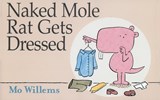by SCR Staff
An Interview with Author and Playwright Mo Willems
Meet Mo Willems

Mo Willems is an American writer, animator, voice actor and creator of children’s books. He first became interested in cartoon art when he was a child and began his professional career as a writer and animator for PBS’ “Sesame Street,” for which he was awarded six Emmy Awards for his writing. During his nine seasons at “Sesame Street,” Willems served as a weekly commentator for BBC Radio and created two animated series, “The Off-Beats” (Nickelodeon) and “Sheep in the Big City” (Cartoon Network). While serving as head writer for Cartoon Network’s “Codename: Kids Next Door,” Willems began writing and drawing books for children. His debut effort, Don’t Let the Pigeon Drive the Bus!, became a New York Times Bestseller and was awarded a Caldecott Honor (2004). Since then, Willems has written more than 50 children’s books, including Naked Mole Rat Gets Dressed, which was published in 2009.
In this interview from Publishers Weekly, author Mo Willems talks with critic John A. Sellers about naked mole-rats, his writing process and the message behind the story of Naked Mole Rat Gets Dressed.
John A. Sellers: So, I’ve looked up pictures of real naked mole-rats. They’re kind of terrifying. What made you decide to feature these creatures in your new picture book?
Mo Willems: Unfortunately, the answer to most questions I get is, “Because it’s funny.” Just like the pigeon, I suppose, naked mole-rats weren’t taken. Bunnies and mice and cute little piggies—they’re pretty much taken. Also, I thought it was time to do an underground story.
JS: I’m not sure if it’s the teeth or the wrinkly skin that’s more upsetting.
MW: They do look like members of my extended family.
JS: Was the fact that there’s a fun adjective in the animal’s name a factor?
MW: Absolutely—it’s a funny name for an animal. A bear isn’t called a furry tooth bear, so certainly there’s a play on words there that made it fun.
JS: But your naked mole-rats are actually cute. Do you try to capture certain innate qualities of animals when using them in your books?
MW: I’m always trying to do as little as possible, because I want my audience to put in as much as possible. In this case, the formal challenge was to be able to show emotion without a mouth. You can’t tell if they’re smiling or frowning. You have to do it entirely through body language. I’m not sure if it was an influence or not, but while I was working on this book, I had gone to the Charles M. Schulz Museum. I got to meet Jean Schulz, Sparky’s widow, and they gave me one of his nibs, which I used. The characters kind of “Snoopified” after a while. There’s something so ungainly about naked mole-rats. Since I couldn’t make them ugly, I decided to make their heads as big as possible—like one small tremor and they would all topple over. They are precarious in their posture.
JS: Have you had the chance to read this book to kids yet?
MW: I have. I’ve read the F&G [folded and gathered], which is the last step before a book is bound, printed and published to a few groups of kids. It’s always interesting to see their responses. They react to things you wouldn’t expect them to, and don’t react to things you think they would. All the other naked mole-rats yelling “Ew!” and “Gross!” [upon seeing Wilbur in clothing] seems to be hilarious, which is gratifying.
JS: But despite the G-rated nudity, this seems at heart a fairly straightforward story about being true to yourself. What’s your take on the best way to present a “message” in a story? How much does that factor in when you’re putting a book together, if at all?
MW: I almost try not to put a message in a book, because I want the audience to come to it and find out what they think about it. What I’m interested in is seeing what they think this story is about. It’s certainly a book about community. I’m usually wrong when I say what my books are about, but in my mind, if there’s anything there I was bringing to it, it was a plea for moderation. It’s not a book where, at the end, everyone is dressed. It’s not about changing opinions from right to wrong. Hopefully it’s more subtle and more peaceable.
(Interview adapted from Publishers Weekly website.)


